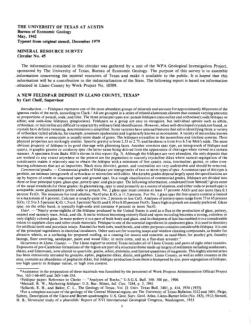Publication Details
Get the Publication
Abstract/Description:
Feldspars represent one of the most abundant groups of minerals and account for approximately 60 percent of the igneous rocks of the earth, according to Clark. All are grouped in a series of related aluminum silicates that contain varying amounts or proportions of potash, soda, and lime. The three principal types are: potash feldspars (microcline and orthoclase); soda feldspar or albite; and soda-lime feldspars (plagioclase). Feldspars as a group are easy to recognize, but individual species such as albite, orthoclase, or microcline are difficult to separate by ordinary field identification. However, when well-developed crystals are found, or crystals have definite twinning, determination is simplified. Some varieties have unusual features that aid in identifying them; a variety of orthoclase called adularia, for example, possesses opalescence and is generally known as moonstone. A variety of microcline known as amazon stone or amazonite is usually some shade of green. The feldspars crystallize in the monoclinic and triclinic systems. Their physical properties are strikingly similar. Specific gravity is from 2.55 to 2.75, and hardness is from 6 to 6.5 in Mohs' scale. The most obvious property of feldspar is its good cleavage with glistening faces. Another common spar type, an intergrowth of feldspar and quartz, is graphic granite or corduroy spar, the latter name being derived from the appearance of cleavages when viewed in a certain manner. A specimen from Badu Hill is shown in this report (fig. 3). Although the feldspars are very abundant, the only deposits that are worked to any extent anywhere at the present are the pegmatites or coarsely crystalline dikes where natural segregation of the constituents makes it relatively easy to obtain the feldspar with a minimum of free quartz, mica, tourmaline, garnet, or other iron-bearing substances that act as impurities. Black mica (biotite), garnet, and tourmaline are very undesirable and should be removed.
